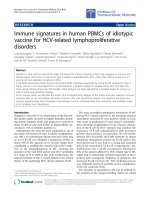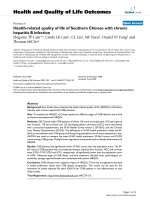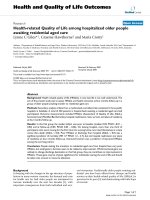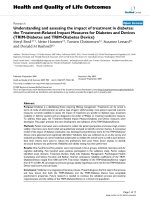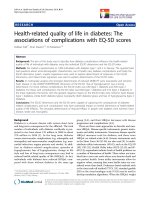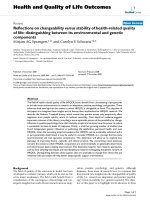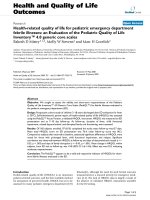báo cáo hóa học:" Occupationally related bilateral calcific tendonitis of Flexor carpi ulnaris: case report" pdf
Bạn đang xem bản rút gọn của tài liệu. Xem và tải ngay bản đầy đủ của tài liệu tại đây (190.29 KB, 2 trang )
BioMed Central
Page 1 of 2
(page number not for citation purposes)
Journal of Orthopaedic Surgery and
Research
Open Access
Case report
Occupationally related bilateral calcific tendonitis of Flexor carpi
ulnaris: case report
Mark Edmondson* and Andrew Skyrme
Address: Eastbourne District General Hospital, Kings Drive, Eastbourne, BN21 2UD, UK
Email: Mark Edmondson* - ; Andrew Skyrme -
* Corresponding author
Abstract
We present a case of bilateral calcific tendonitis of the Flexor Carpi Ulnaris attributable to
repetitive wrist action which was occupationally related. This was treated conservatively with
avoidance of aggravating movement, resting splints and anti inflammatory medication when acute
flare ups occurred. Since avoidance of repetitive strain on the wrists he has had no further flare ups
in over 2 years. This is the only case of bilateral calcific tendonitis of Flexor Carpi Ulnaris that has
been reported in the literature, further more it is the only one which has been attributed to
occupation and settled following a change of career.
Introduction
Calcium deposits may occur in virtually any tendon or lig-
ament although they are more common in the rotator cuff
of the shoulder. Calcific deposits tend to arise in tendons
secondary to chronic inflammation. Chronic inflamma-
tion can arise from repetitive strain injuries resulting from
repeated stress to the body's soft tissues. They often occur
in patients who perform repetitive movements either in
their jobs or in extracurricular activities. However it is not
uncommon to find calcific deposits within the tendons of
patients who cannot recall any provocative factors. We
report a case of bilateral calcific tendonitis of Flexor Carpi
Ulnaris tendons at the wrist which correlates with occupa-
tionally related repetitive strain.
Case report
A 42 year old male Hospital porter presented to our out-
patient clinic with bilateral wrist pain. The pain was local-
ised to the volar and ulna aspect of both wrists with
specific tenderness along the course of the Flexor Carpi
Ulnaris tendon proximal to the pisiform. There was palpa-
ble nodularity throughout these tendons. The pain was
aggravated by flexion and ulna deviation of the wrist dur-
ing examination in clinic. His right wrist was worse than
his left, and he attributed this to his work as a porter
which involved turning patients' beds to the right and left
which significantly strained his forearm flexors (and spe-
cifically the ulna sided ones to flex the wrist). Xray exam-
ination revealed bilateral calcific tendonitis of Flexor
Carpi Ulnaris (Figure 1).
He does not suffer from hypercalcaemia, have any meta-
bolic abnormalities and does not suffer from CREST syn-
drome (Calcinosis Raynauds Esophagitis Scleroderma
Telangiectasia).
He was managed conservatively with avoidance of pro-
vocative movement, resting splints and NSAIDS for pain-
Published: 23 August 2009
Journal of Orthopaedic Surgery and Research 2009, 4:33 doi:10.1186/1749-799X-4-33
Received: 8 April 2009
Accepted: 23 August 2009
This article is available from: />© 2009 Edmondson and Skyrme; licensee BioMed Central Ltd.
This is an Open Access article distributed under the terms of the Creative Commons Attribution License ( />),
which permits unrestricted use, distribution, and reproduction in any medium, provided the original work is properly cited.
Journal of Orthopaedic Surgery and Research 2009, 4:33 />Page 2 of 2
(page number not for citation purposes)
ful exacerbations. The patient infact changed his career to
work in the mortuary rather than as a porter and this aided
in avoiding exacerbation of his pain.
On review, 2 years since original presentation, he has had
no further flare ups since changing careers.
It is also noteworthy that the calcific deposits were still
present on radiographic examination of his right wrist at
this stage (Figure 1) despite resolution of symptoms, but
not in his left.
Discussion
A calcium deposit at the insertion of Flexor Carpi Ulnaris
following trauma was first described by Cohen in 1924
[1]. Calcareous tendonitis in the metacarpophalangeal
joint region was reported by Cooper in 1942 [2], present-
ing with severe local tenderness, swelling and erythema.
Carrol et al described the commonest site for calcific
deposits along the Flexor Carpi Ulnaris to be near the pis-
iform [3], this has further been described as calcification
within the pisiform bursa [4]. Yelton and Dickey
described 97 cases of calcification around the hand and
wrist 2/3 s of which were in the metacarpophalangeal
region [5], they found that injection of local anaesthetic in
the acute stages gave lasting relief and postulated that the
physical act of needling the deposit produced this result.
More recently Moyer et al described 12 cases of calcific
tendonitis of the hand and wrist which was deemed to be
idiopathic as no initiating trauma or repetitive strain
could be identified [6]. Pathogenesis of calcific tendonitis
remains unclear, although tendon fibre damage, dys-
trophic calcification, and hypoxia have been implicated
[7].
Calcific tendonitis can present with severe pain and ten-
derness along the tendon coupled with intense erythema.
Presentations like this can often raise the suspicion of
infection, it is worth bearing in mind the possibility of cal-
cific tendonitis in such cases. Review of the literature
revealed no cases of either bilateral Flexor Carpi Ulnaris
Calcific tendonitis or occupationally related calcific ten-
donitis of the Flexor Carpi Ulnaris. Our case is unusual in
that it is bilateral and related to repetitive strain.
Consent
Written informed consent was obtained from the patient
for publication of this case report and any accompanying
images. A copy of the written consent is available for
review by the Editor-in-Chief of this journal.
Competing interests
The authors declare that they have no competing interests.
Authors' contributions
Both authors were involved with the assessment and sub-
sequent follow up of this patient. Both authors read and
approved the manuscript.
Author information
Mark Edmondson is a Trauma and Orthopaedics Registrar
and Andrew Skyrme is a Trauma and Orthopaedic Consu-
lant at the Eastbourne District General Hospital, Kings
Drive, Eastbourne, BN21 2UD, UK.
References
1. Cohen I: Calcareous deposits at the insertion of flexor carpi
ulnaris tendon following trauma. American Journal of Surgery
1924, 38:172-3.
2. Cooper W: Calcareous deposits in the metacarpophalangeal
region. Journal of Bone and Joint surgery 1942, 24:114-22.
3. Carrol RE, Sinton W, Garcia A: Acute calcium deposits in the
hand. Journal of the American Medical Association 1955, 157:422-6.
4. Cameron BM, McGee FO: Calcification of the pisiform bursa:
report of two cases. South Medical Journal 1958, 51:496-8.
5. Yelton CL, Dickey LE: Calcification about the hand and wrist.
South Medical Journal 1958, 51:489-95.
6. Moyer RA, Bush D, Harrington T: Acute calcific tendonitis of the
hand and wrist: a report of 12 cases and a review of the liter-
ature. The Journal of Rheumatology 1989, 16(2):198-202.
7. Greene TL, Louis DS: Calcifying tendonitis in the hand. Annals of
Emergency Medicine 1980, 9:438-40.
Radiographs of Right wrist demonstrating Calcific tendonitis of Flexor Carpi UlnarisFigure 1
Radiographs of Right wrist demonstrating Calcific
tendonitis of Flexor Carpi Ulnaris.
